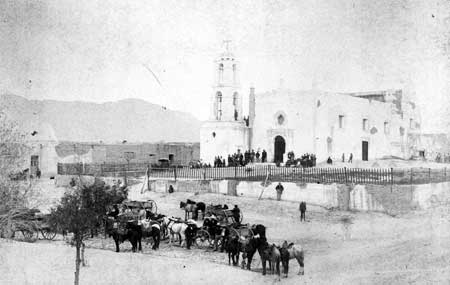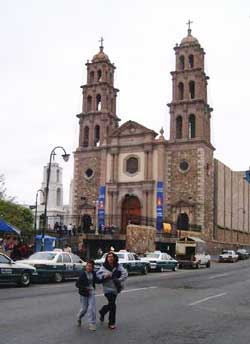
Winemaking Starts in Texas:
A Retrospective “Tasting” with Father Garcia de San Francisco y Zuniga
“When we entered the region, we saw grapes growing wild along the rivers of Tejas and they looked like I imagined they did for eons. The vines were thick, hanging from the trees on the river banks.”
This is how Father Garcia de San Francisco y Zuniga recalled the local landscape as he, Father Juan de Salazar and ten Christianized Indian families made their trek in 1659 into what was called Tejas and is now the state of Texas. The group came from Mexico with the hope of establishing a Spanish settlement. The mission, founded the same year, became known as Mission Nuestras Senora de Guadalupe and can be found in Juarez on the Mexican side of the Rio Grande. With time, the surrounding settlement became El Paso Del Norte located on the opposite side of the river and is presently known as El Paso, Texas.
 My ethereal tasting with Father Garcia took place on a patio just off the plaza near the mission in the shade of a lone oak tree. Father Garcia continued, “We cultivated the land around the mission as part of our missionary work. We brought vine cuttings from which we grew grapes to make sacred wines for our masses. Once the vineyards and winery were established, they provided sacramental wines for our mission and others in Tejas and Mexico.”
My ethereal tasting with Father Garcia took place on a patio just off the plaza near the mission in the shade of a lone oak tree. Father Garcia continued, “We cultivated the land around the mission as part of our missionary work. We brought vine cuttings from which we grew grapes to make sacred wines for our masses. Once the vineyards and winery were established, they provided sacramental wines for our mission and others in Tejas and Mexico.”
Father Garcia also mentioned that the craft of winemaking in the Americas went back another one hundred years or so before his viticultural efforts. It started in 1557 and was borne on the “cordon” of one grape variety that arrived from Spain. It was a low-grade but hardy vinifera grape with a pinkish skin known as Criolla that took root in South America. However, the modern-day name of this grape is “Mission” in remembrance its use in the Spanish Missions.
A Taste of Mission Wine
As I opened the bottle and poured two glasses of Mission wine, Father Garcia lamented, “There was always a debate as to the lineage of the grapes that we brought to Tejas. Some attributed our grapes to the Argentines, others implicated the Chileans. I think that both were involved; first the Argentines and then the Peruvians as the grape moved farther north. As I remember, the variety of grapes that we brought to Tejas came from Peru.”
— — — — —
The full story from his blog will be published in an upcoming book by Russ Kane. Stay tuned for details as the publications date gets closer.

Be the first to comment